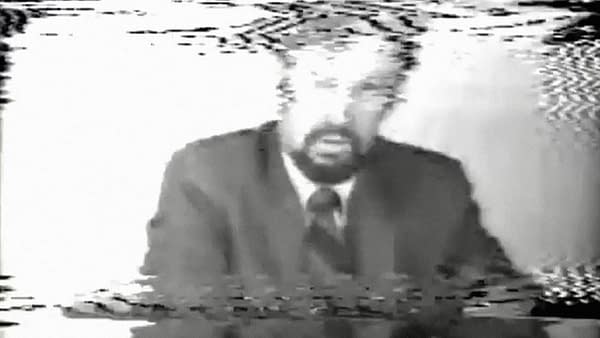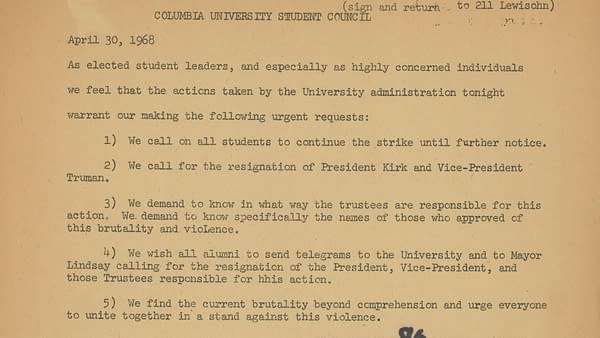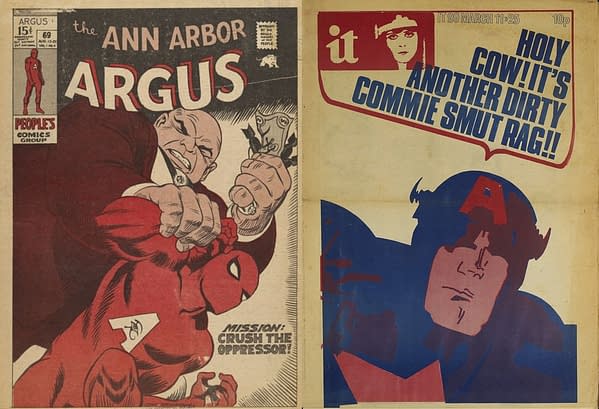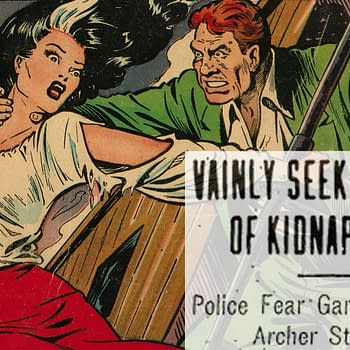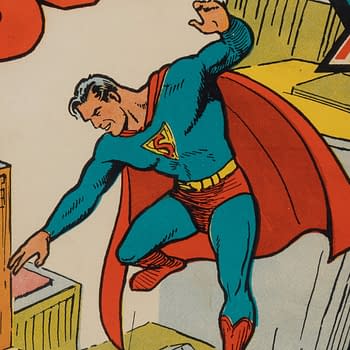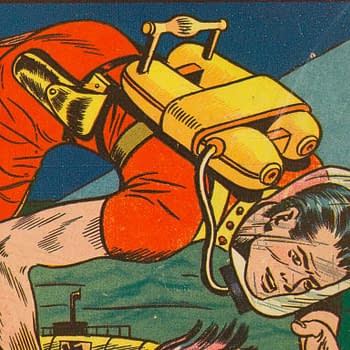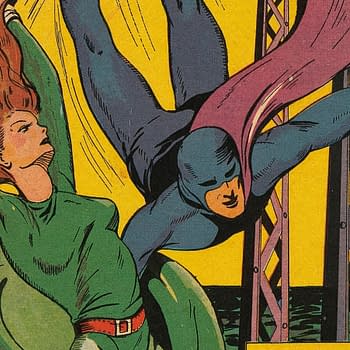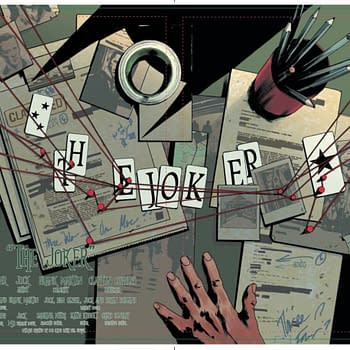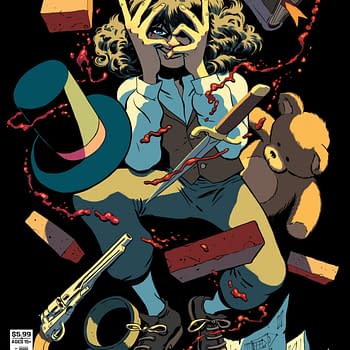Posted in: Comics | Tagged: #marveldeclassified, marvel declassified, stan lee
Marvel Declassified 3: All Sorts of Subliminal Messages
I love comics history and the history of American periodicals in general, and enjoy figuring out things about that history that few people know. The Bleeding Cool staff has heard so many of these forgotten moments from our printed-matter past, that Rich occasionally stops me mid-anecdote and tells me I ought to do a post about it, so that everybody can read about that particularly Amazing Moment That Time Forgot, and the staff can get back to work. It's a great pleasure for me to write about such things, but the research is necessarily very time consuming.
I've written up a few interesting tidbits here, like the Doctor Strange of 1876, the weird political History of America's First Iron Man, the actual genesis of the phrase Friendly Neighborhood Spider-Man, Wonder Woman's relationship to the Angel of Mons World War I legend, this far-too-brief bit about the historical iconography of fictional hate, and a fascinating thing about that time the creator of Steel Sterling set off a fake news controversy resulting in a Senate Subcommittee hearing on December 17, 1964.
All of these things are very interesting to me, but I've found I don't really have a good nose for what other people will think of these obscure secrets locked up inside the past couple of centuries of crumbling old paper. Some of the above was well read, some of it wasn't. Mostly, I'm just scratching an itch to get it out there into the world, and making it searchable. I recently heard from a researcher at an institution mentioned in this post about a fan convention held in New Jersey in 1889, who wanted to know more, and I see a writer for the Smithsonian recently picked up on my research of that matter also. That's reason enough to put such things together and get them out there in a place where somebody else who is interested might find them.
This one is going to be different, though.
The series of posts that we're calling Marvel Declassified was born out of my annoyance over how many times I'd seen incorrect info about the genesis of Marvel's Black Panther repeated in the months leading up to the debut of the Black Panther film earlier this year. I figured I'd spend a few hours on it over a weekend, and get it out there on the record.
Halfway through it, I realized I was going to want to include some previous examples of Lee and Kirby doing what they did with Black Panther, part of which includes drawing inspiration from specific real-world events. There are several well-known instances of this happening in a general way during the genesis of Marvel Age. Everyone knows it's there in broad strokes: The cold war space race of the Fantastic Four, Tony Stark in the Vietnam jungle, Nikita Khrushchev and Chairman Mao showing up from time to time.
I also realized that in regards to Black Panther, there are several lesser-known theories about how that actually played out, but none of them quite work, in my opinion. I dug into the Black Panther story for quite a long time — particularly the Coal Tiger part — and finally, it all dropped into place. Except that it presumes a degree of political and world-event savvy that we usually don't ascribe to Stan Lee and Jack Kirby as we think of them. I was discussing this with some comics history buffs recently, and there was significant skepticism that Jack and/or Stan would've even done the cursory research necessary to discover that, you know… there are no tigers in Africa.
But finally, at one point during my research, I came across this 1968 video of Stan Lee taking part in a roundtable of journalists which includes Jeff Shero, editor of a New York City underground newspaper RAT Subterranean News, Chuck Skoro, managing editor of the Columbia Daily Spectator student newspaper, and Skip Weiss, editor of the Daltonian school newspaper. The subjects discussed are complex, and range from Vietnam to the Congo and beyond. Obviously, I'm not the first person to stumble across this video, which has been online since 2015 but has generated little discussion. Shero told Sean Howe that it was a pilot for a proposed talk show. I've reached out to Shero myself seeking additional information.
This is not Excelsior! Stan Lee, the showman who might gloss over your question about what inspired him to create a character with a vague but entertaining story about some half-remembered pulp. This is a very different Stan Lee. The Excelsior! mask slipped a bit. It came off completely, in fact.
Early on, part of the conversation made me sit up and pay attention, because it relates directly to what I'll be covering regarding the creation of the Black Panther in four Marvel Declassified posts which span that complex and amazing backstory of the Black Panther. Lee notes to Columbia's Chuck Skoro that there'd been some excitement at his school recently. A Columbia University student named Bob Feldman had learned that the school had an affiliation with a weapons research think-tank associated with the Department of Defense. It was discovered that a Columbia University Trustee played a contributory roll in the CIA-sponsored assassination of Democratic Republic of the Congo Prime Minister Patrice Lumumba.
It's a complex, challenging discussion, and it's not the kind of thing we're used to seeing Lee take part in. This is not Lee regaling you with a tale of how he and Jack Kirby created the Fantastic Four or the Incredible Hulk. Except… maybe it sort-of is.
At one point, Jeff Shero tells the group that he's been harassed by the FBI because of his investigation into the Columbia matter. Lee chuckles nervously and replies, "Well, I know that can happen."
Stan once lived in a building in which a now-famous CIA operation took place, in a period during which it was ongoing, so I think he might well have been aware that such things could happen.
But let's back up a minute and give this exchange the attention it deserves. The conversation here between Shero and Lee provides crucial context for the times. It also provides context for some of the backstory I'm laying out here, in part because Shero's contention that he'd forced the country's mainstream news media to react to what he was publishing on the Columbia situation was no idle boast.
The underground newspaper that Shero edited, Rat Subterranean News, was in fact a very important political and cultural force in this era. RAT shaped the news of the Columbia University Trustee matter to a large extent, and was at the bleeding edge of reportage on issues ranging from the continuing rise of the Black Panthers, the controversies of Vietnam, and beyond. William S. Burroughs, Allen Ginsberg, and Jack Kerouac were contributors. Like many underground newspapers of the time, RAT contained comic art — Gilbert Sheldon and Robert Crumb were artistic contributors, among many others. The paper also interviewed figures ranging from Jimi Hendrix to John Lennon to Kurt Vonnegut. A "spoof" that RAT published about the death of Paul McCartney set local rumors on fire and helped turn "Paul is Dead" into an urban legend.
From our present perspective on this 1960s period, this conversation between Stan Lee, one of the architects of the Marvel Universe, and Jeff Shero, an important voice of 1960s American counterculture, is a remarkable moment to observe. Shero lets us know he's willing to go toe-to-toe with Lee early on. Asked by Lee if he's journalist or provocateur, he replies:
I'm both, because we don't believe that there's anything like passive journalism. There's only participatory journalism. The New York Times and The RAT are both expressing biases. The New York Times is the elite version of our American history, And The RAT is another version of our history, but it's the version of the insurgency.
Stan later takes Shero to task over what he calls the obscenity in underground newspapers, by which he means nudity and other graphic situations that the undergrounds often included in art and photos (he later notes that he subscribes to "all of them"). You can see Shero rocking back and forth in his seat as he listens to Stan tee up the question. And when Stan is done, Shero again punches back:
I am worried about obscenity in newspapers. I always see it particularly in the Daily News and New York Times, the stuff about Vietnam and nuclear war, and starving children. The obscenity is horrible, and we try to avoid the obscenities of society or deal with them in a good way in The RAT as much as possible; try to build those forces of change. But the fact is that it's an obscene world that we live in, and those obscenities have to end.
Boom. Now it's on. And next, it's Stan's turn to push back. He starts off lecturing, perhaps a bit patronizing. It feels a little like Stan wants Shero to know that he might just have a thing or two to teach the young journalist. And in that moment, he says something unexpected:
Well, you see… philosophically, I know what you're saying. But I just wonder if I were editing an underground newspaper or any newspaper, and I had some sort of a message, or some sort of a mission. It would seem to me, I would want to present it in a way that would give me the widest possible audience. Now the magazines that I edit, we have all sorts of subliminal messages in these magazines [my emphasis]. But we don't do anything in the magazines that will turn any segment of the readership away from us. At least we don't do it intentionally.
One can draw some interesting conclusions from just the notion that in speaking to a self-styled political provocateur, Stan Lee explains that if he had a message or mission, he'd want to find a way to reach the widest possible audience. And in the very next moment, he states that they have "all sorts of subliminal messages" in the Marvel comics that he edits.
It also feels a little like he wants this to be a teaching moment for Shero. Rubbing it in people's faces isn't the only way, he might be saying. There might be more subtle ways of getting the same message across.
Watching this video shook me off of my notion of Excelsior! Stan Lee just enough that I decided to go back and look at some of the key moments in Marvel history with a different set of assumptions than I have before. Don't assume that Stan was the carnival barker showman with a perpetually foggy memory, who often seemed content with letting his creative partners become the driving forces of the Marvel Universe. Do assume… something else. Something with the type of mindset that the video above might imply.
What I found surprised me, to say the least. In my opinion, certain details of the inspiration of the Marvel Universe during the 1960s are significantly different than what's been suggested by anyone, including Marvel's foundational creators. I'm not talking about vague influences of the times. There are very many direct, closely-coupled influences which have never been discussed. I don't know to a certainty why these things were left unsaid by creators and staff who probably realized.
I have a few guesses. It's not unlikely that a few people who were there at the time, or people who knew them, will bring some clarity to those theories and discussions now. But as I sit here noodling with drafts of the next several chapters in this weird and unknown aspect of the origin of the Marvel Universe, I'm still reserving judgment regarding what I think about the reasons it was done.
Post comment response to the first two Marvel Declassified installments about Hulk and Spider-Man is neatly divided between a) 'they were obviously influenced by the times, this isn't news', and b) 'there's no relationship between these things at all'.
Part of the response is the result of the particular way that I've been telling the tale. The visual connections are important, but they are (typically) just a part of the total picture. For example, the idea that a fictional, cigar-chomping, infamously belligerent U.S. General in charge of our gamma bomb development and tests is based on a real-life cigar-chomping, infamously belligerent U.S. General in charge of our nuclear bomb development and tests (and at the time of the development of the Hulk storyline, extremely well-known among the public in part for his role in nearly triggering a Constitutional crisis in late 1961 through early '62 over the funding and development of the B-70 Valkyrie Supersonic Strategic Nuclear Bomber ) is sufficient basis for making the connection to his probable role in inspiring a character which made his debut in early May 1962 (Library of Congress copyright date, our best general indicator of release date).
Whether you believe that's trivially obvious, or believe that it can be explained away as coincidence, I've got very many other specific examples, and some compelling context that ties it all together, that may change your mind.
I think I'm going to make you a True Believer soon. In total, the data I've put together is compelling, there's an overwhelming amount of it, and I think that the Marvel Declassified series is going to paint a different picture of the genesis of the Marvel Universe than you've likely ever contemplated before.
And remember Stan's statement that he reads many underground newspapers in the video here, which he certainly seems to back up with specific knowledge throughout the conversation. If Stan was aware of the underground newspaper scene, that scene was certainly aware of Stan and Marvel, and that's going to come up at an interesting moment in a future Marvel Declassified.


